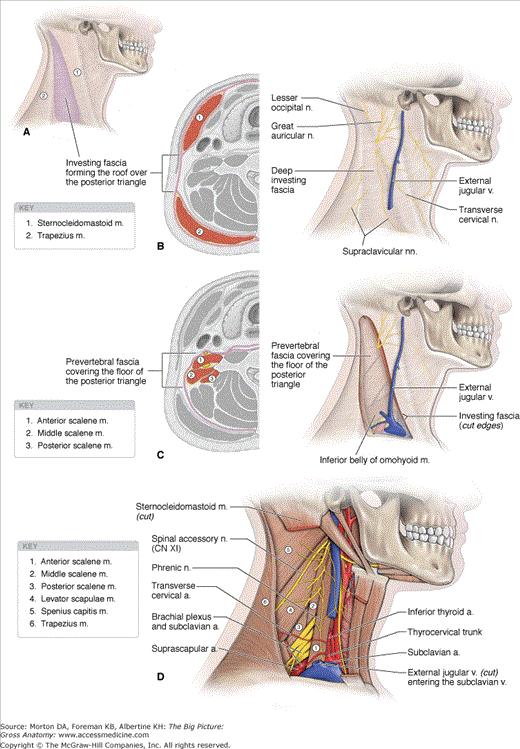Posterior Triangle of the Neck
The neck region is divided into triangles to compartmentalize the contents. The sternocleidomastoid muscle divides the neck region into posterior and anterior triangles. The posterior triangle of the neck is located on the lateral aspect of the neck.
The boundaries of the posterior triangle are as follows (Figure 26-1A):
- Anteriorly. The sternocleidomastoid muscle.
- Posteriorly. The trapezius muscle.
- Inferiorly. The clavicle.
Figure 26-1
A. Boundaries of the posterior triangle of the neck. B. Cross-section and lateral view of the deep investing fascia surrounding the sternocleidomastoid and trapezius muscles. C. Cross-section and lateral view of the prevertebral fascia covering the prevertebral muscles. D. Prevertebral fascia removed from the posterior triangle of the neck.
The roof of the posterior triangle of the neck consists of the investing layer of the deep cervical fascia that surrounds the neck, enveloping the sternocleidomastoid and trapezius muscles (Figure 26-1B). The sensory branches of the cervical plexus and the external jugular vein pierce the investing layer of cervical fascia.
The sensory branches of the cervical plexus course between the anterior and middle scalene muscles piercing the investing fascia at the posterior border of the sternocleidomastoid muscle en route to their respective cutaneous fields (Figure 26-1B).
- Lesser occipital nerve (C2 contribution). Ascends along the posterior border of the sternocleidomastoid muscle en route to the skin of the neck and scalp, behind the ear.
- Great auricular nerve (C2–C3 contributions). Ascends over the sternocleidomastoid muscle en route to the skin of the parotid region and ear.
- Transverse cervical nerve (C2–C3 contributions). Courses horizontally over the sternocleidomastoid muscle en route to the skin on the anterior and lateral sides of the neck.
- Supraclavicular nerve (C3–C4 contributions). Descends obliquely across the posterior triangle of the neck to the skin over the clavicle and superior region of the thorax.
The external jugular vein descends vertically across the superficial surface of the sternocleidomastoid muscle, between the platysma muscle and the investing fascia. The external jugular vein pierces the investing fascia where it joins with the subclavian vein.
The prevertebral fascia forms the floor of the posterior triangle of the neck (Figure 26-1C and D).
The following structures are superficial to the prevertebral fascia:
- Inferior belly of the omohyoid muscle. Courses from the hyoid bone en route to the scapula within the pretracheal fascia.
- Transverse cervical artery. A branch from the thyrocervical trunk that courses along the floor of the posterior triangle en route to the deep surface of the trapezius muscle. The artery bifurcates into a superficial branch, which courses superficial to the rhomboid muscles, and a deep branch, which courses deep to the rhomboid muscles.
- Suprascapular artery. The most inferior branch from the thyrocervical trunk, the suprascapular artery courses across the anterior scalene muscle and the phrenic nerve, where it crosses over the superior transverse scapular ligament to enter the supraspinous fossa.
- Spinal accessory nerve [cranial nerve (CN) XI]. Exits the jugular foramen and obliquely descends along the prevertebral fascia en route to the sternocleidomastoid and trapezius muscles.
 The spinal accessory nerve is one of the more vulnerable structures during any surgical procedure involving the posterior triangle of the neck. During surgery, careful isolation and protection of this nerve is essential to avoid spinal accessory nerve damage.
The spinal accessory nerve is one of the more vulnerable structures during any surgical procedure involving the posterior triangle of the neck. During surgery, careful isolation and protection of this nerve is essential to avoid spinal accessory nerve damage.
The following structures are deep to the prevertebral fascia:
- Cervical muscles, from superior to inferior:
- Splenius capitis
- Levator scapulae
- Posterior scalene
- Middle scalene
- Anterior scalene (notice that the phrenic nerve descends vertically along the anterior surface of the anterior scalene muscle en route to the thoracic cavity).

- Splenius capitis
- Brachial plexus and subclavian artery. The brachial plexus and the subclavian artery course between the anterior and middle scalene muscles, and as the nerve plexus and artery emerge from those muscles, they carry an extension of the prevertebral fascia along to form the axillary sheath.
 Thoracic outlet syndrome consists of a group of disorders related to the exit of the brachial plexus and the subclavian artery between the neck and the upper limb. Most disorders are caused by compression of the brachial plexus or subclavian artery. Compression may be caused by the clavicle, movement of the shoulder joint, or an enlargement of muscles surrounding the plexus or vessel.
Thoracic outlet syndrome consists of a group of disorders related to the exit of the brachial plexus and the subclavian artery between the neck and the upper limb. Most disorders are caused by compression of the brachial plexus or subclavian artery. Compression may be caused by the clavicle, movement of the shoulder joint, or an enlargement of muscles surrounding the plexus or vessel.
 The region between the anterior and middle scalene muscles where the brachial plexus exits is referred to as the interscalene triangle
The region between the anterior and middle scalene muscles where the brachial plexus exits is referred to as the interscalene triangle
Stay updated, free articles. Join our Telegram channel

Full access? Get Clinical Tree



